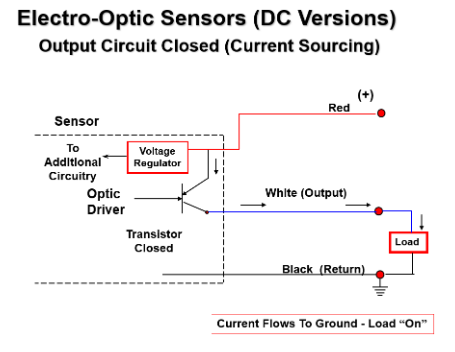
Sinking and Sourcing are terms used to describe how an associated load (the device being turned on or off by the sensor) is powered in relation to the sensor.
Here’s a simple way to tell if you want sinking or sourcing load: If you want to see the voltage as well as the transistor logic on the output wire when on, you want sourcing. If you do not want to see the voltage (0V) and only want the transistor logic on the output wire, you want sinking, because voltage sinks to ground.
Sinking
In a sinking configuration, current passes through the load first, through the output switch of the sensor second and lastly to ground. It is a transistor logic output that switches the DC ground, or negative, leg of the circuit.
Sinking Path (NPN):
Power > Load > Sensor > Ground = Sinking
Example: 5VDC Optic Sensor, Wet Sink, load is an LED.


Sourcing
In a sourcing configuration, the load must be connected between the sensor output and the DC ground. With a sourcing sensor, your input voltage powers the load. It is a transistor logic output that switches the DC positive voltage. The sensor is the source of the current required to power the load. Current supplied by the sensor passes through the load second and then to ground. A sensor with a sourcing output switches the positive leg of the circuit.
Sourcing Path (PNP):
Power > Sensor > Load > Ground = Sourcing
Example: 5VDC Optic Sensor, Wet Source, load is LED.


